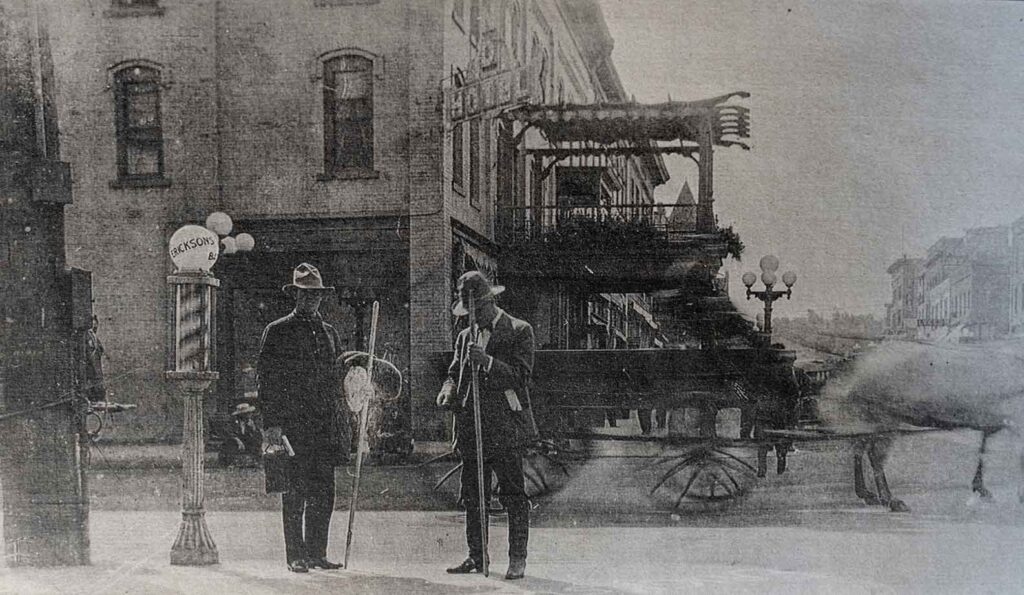
Lethbridge was the nearest railroad point and was some 35 miles north of the ranch. The trip to Lethbridge was a rare event and was generally made in a wagon for the purpose of bringing back lumber or ranch supplies. It took a matter of four or five days to complete the wagon trip, and the driver would take his bed roll, a grub box and some oats for the horses and camp for a couple of nights on the way back to the ranch with his load. Most men at the ranch got busy writing letters or thinking what they needed from town whenever such a trip was made. The teamster making the trip had a busy time in town filling their orders for tobacco, socks, shoes, gloves, shirts, underwear and numerous other things which many wanted.
Our foreman during this time was the late Mr. Edward Kenny of Calgary, Alberta, who had worked for my father as a very young man on his ranch in Utah. He was a good cattleman and a good one to plan his work. He stayed as ranch foreman until the year 1901 when he formed a partnership with a man named Sheets and located his own ranching operations in the Rosebud Creek east of Calgary.
It was the summer of 1898 when I first went to the ranch with my father and cousin, Owen Dix, was taken along with me. We both wore knee britches and our imaginations ran wild with thoughts of what Canada was going to be like. Beginning with the summer of 1898 I came to the ranch nearly every summer during vacation periods from school. This continued until the year 1908 when I had finished school and from then on I worked on the ranch for about nine or ten months of each year. This continued until 1930 when, because of my father’s death, I have had to spend about seven months of each year in Utah, looking after family interests there. My brother, Robert Bradford McIntyre, who was four years younger than I, followed the same pattern until his death at the ranch in the ‘flu epidemic of October 1918. He was 27 years old when he died. He was over six feet in height and became a real cow hand, a fine roper, as well as a good mechanic. He was taking a correspondence course Electrical Engineering at the time of his death.
After the death of my brother, Bob, my father said that he never wanted to see the ranch again, and would not visit it until my marriage in the year 1920 to Miriam Elizabeth Stoltze, of Lethbridge, only daughter of the late Frank A. Stoltze, a lumberman who came west from Wisconsin. My father and mother came to Lethbridge for my wedding and then back to the ranch for another look at it. This visit softened the bitterness caused by Bob’s death, and father became a regular visitor for the rest of his life. Four married daughters and I survived him.
(To Be Continued)
Wednesday, August 20, 1947
I remember that my father had shipped a buckboard from Salt Lake to Lethbridge. When we arrived at Lethbridge, the buckboard was already in the railway freight shed and my father had to clear it through the Canadian Customs. There was one rate of duty for a utility wagon and a much higher rate of duty imposed upon a pleasure vehicle. The customs officers insisted that the buckboard was a pleasure vehicle and my father contended that it was a utility wagon, that he could haul almost a ton on it, and that if he wanted to use the wagon for pleasure he would not be driving it over the open prairies of Alberta. After a long argument the buckboard had to be classed as a pleasure wagon.
That was my first introduction to the Customs and the same arguments and difficulties have persisted all through the years up to the present time. Canada is not the only offender. Your get it in the neck going both ways. After putting the buckboard together my father rented a livery team from Curly Whitney who ran the livery stable at that time, and we started in the late afternoon for the ranch. The trail we followed was an old hay trail that was used in hauling hay from the Milk River Ridge to Lethbridge. It took some eight hours to make the trip of 35 mile and all the way we did not see a fence, a house or a person until we arrived at the ranch about ten o’clock that evening. The towns of Raymond and Magrath had not been started.
